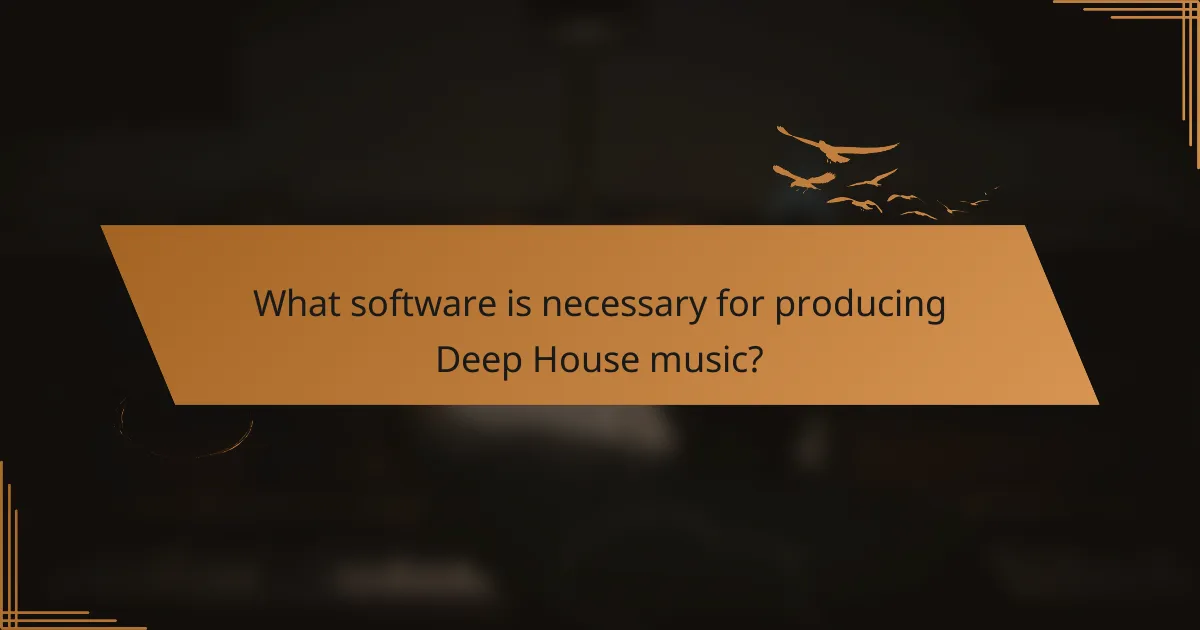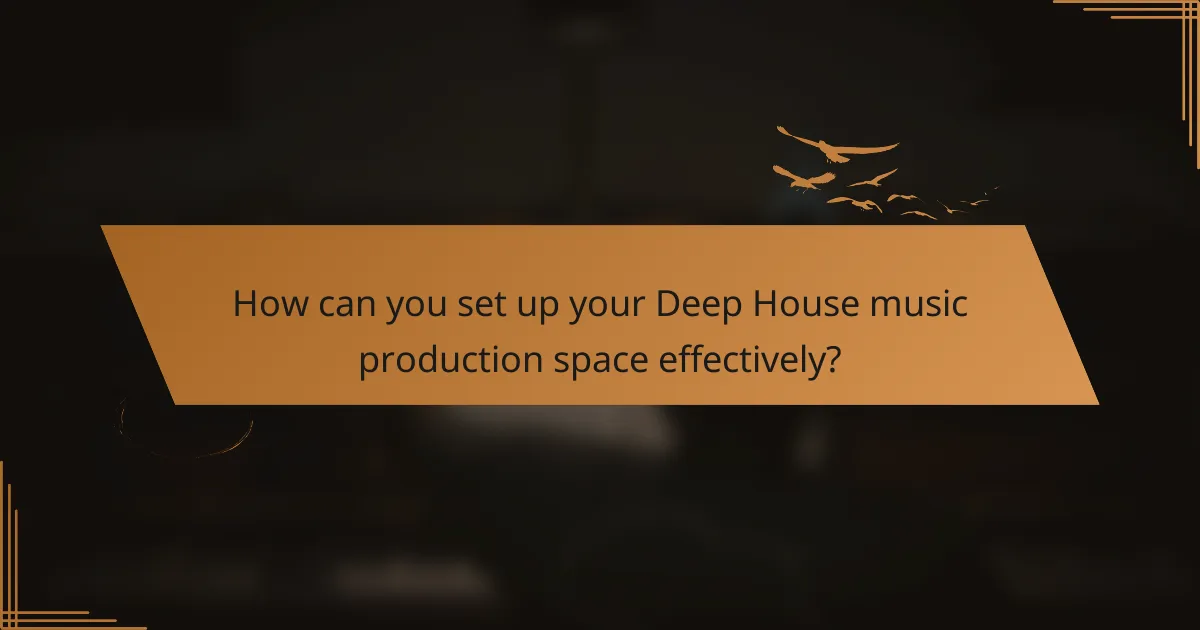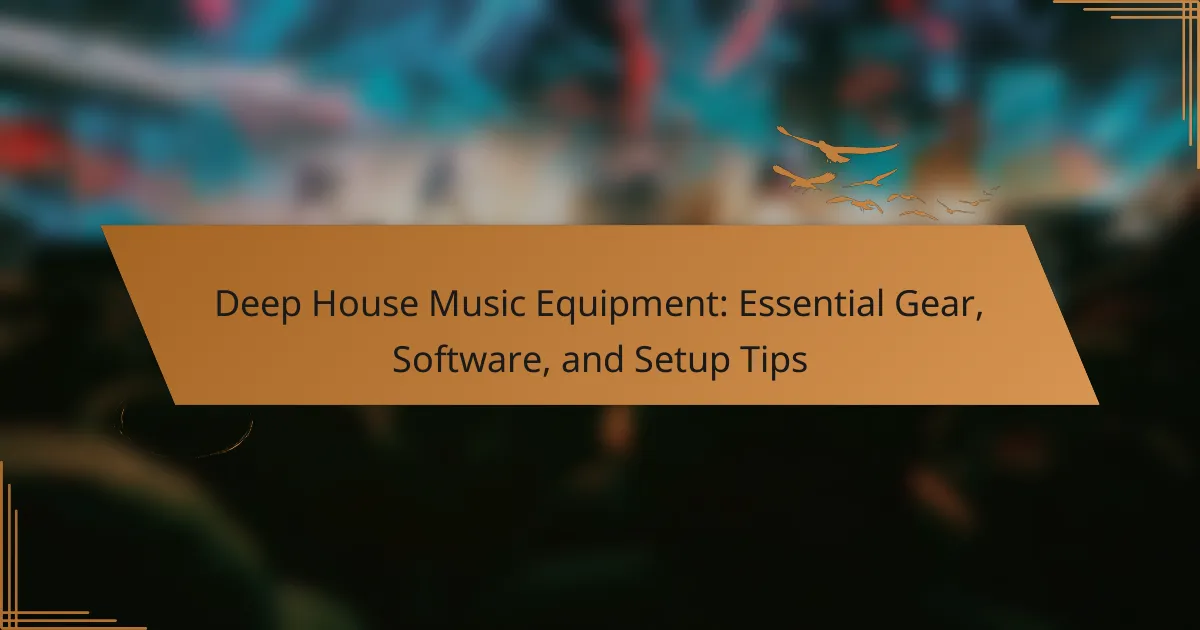Deep house music equipment encompasses the essential tools and devices used for creating, producing, and performing deep house music. Key components include synthesizers, such as the Korg Minilogue and Moog Sub 37, drum machines like the Roland TR-909, and digital audio workstations (DAWs) such as Ableton Live and FL Studio. This article outlines the specific gear necessary for achieving the deep house sound, highlights the importance of soundproofing and acoustics in a production space, and offers practical setup tips for optimizing workflow and sound quality. Additionally, it discusses the role of plugins and virtual instruments in enhancing music production capabilities.

What is Deep House Music Equipment?
Deep house music equipment refers to the tools and devices used to create, produce, and perform deep house music. This genre typically requires specific gear to achieve its characteristic sound, which includes synthesizers, drum machines, and audio interfaces. Popular synthesizers like the Korg Minilogue or Moog Sub 37 are often used for rich basslines and atmospheric pads. Drum machines such as the Roland TR-909 can provide the iconic deep house beats. Additionally, digital audio workstations (DAWs) like Ableton Live or FL Studio are essential for music production. These platforms allow for arranging, editing, and mixing tracks effectively. High-quality headphones and studio monitors are also crucial for accurate sound representation. Overall, deep house music equipment combines hardware and software to enable artists to craft their unique sound.
How does Deep House Music Equipment influence music production?
Deep House Music Equipment significantly influences music production by providing essential tools for sound creation and manipulation. Equipment such as synthesizers, drum machines, and audio interfaces shape the overall sound quality. High-quality synthesizers allow producers to create rich, textured sounds characteristic of deep house. Drum machines enable precise rhythm programming, essential for the genre’s groove. Audio interfaces improve sound clarity and reduce latency during recording. Additionally, software like digital audio workstations (DAWs) offers extensive editing capabilities. These tools empower producers to experiment and refine their tracks. The right equipment ultimately enhances creativity and production efficiency in deep house music.
What are the key components of Deep House Music Equipment?
The key components of Deep House Music equipment include synthesizers, drum machines, and audio interfaces. Synthesizers generate melodic and harmonic content essential for deep house tracks. Drum machines provide rhythmic elements and beats characteristic of the genre. Audio interfaces convert audio signals for recording and playback, ensuring high sound quality. Additionally, a digital audio workstation (DAW) is crucial for arranging and producing music. Studio monitors are necessary for accurate sound reproduction during mixing. MIDI controllers facilitate live performance and music production by allowing musicians to manipulate sounds. Together, these components create a comprehensive setup for producing deep house music.
How do different equipment types affect sound quality?
Different equipment types significantly affect sound quality in deep house music. Audio interfaces provide higher fidelity and lower latency compared to built-in computer sound cards. High-quality microphones capture clearer vocals and instruments, enhancing overall production quality. Studio monitors deliver accurate sound reproduction, allowing producers to make precise mixing decisions. Headphones, especially studio-grade ones, reveal details in the mix that may be missed on consumer models. Effects processors can shape sound characteristics, adding depth and texture. Synthesizers and drum machines contribute unique tonal qualities, influencing the final sound. Each equipment type plays a crucial role in achieving professional sound quality.
What are the essential gear types for Deep House music?
The essential gear types for Deep House music include synthesizers, drum machines, audio interfaces, and studio monitors. Synthesizers create lush pads and basslines characteristic of Deep House. Drum machines produce rhythmic patterns and beats crucial for the genre. Audio interfaces are necessary for high-quality sound recording and playback. Studio monitors provide accurate sound reproduction for mixing and mastering. These gear types are widely used by producers in the Deep House scene. Their effectiveness is supported by numerous successful tracks that feature these elements prominently.
What role do synthesizers play in Deep House music production?
Synthesizers are crucial in Deep House music production. They create rich, layered sounds that define the genre’s atmospheric quality. Synthesizers generate basslines, chords, and melodic elements. Their versatility allows producers to shape unique sonic textures. Popular synthesizers used in Deep House include the Roland Juno-106 and Serum. These instruments offer a range of presets and customization options. The use of analog and digital synthesizers contributes to the genre’s depth and warmth. Overall, synthesizers are integral to crafting the signature sound of Deep House music.
How do drum machines contribute to the Deep House sound?
Drum machines play a crucial role in shaping the Deep House sound. They provide a consistent and precise rhythmic foundation. This genre often features deep, punchy kicks and crisp hi-hats created by drum machines. The ability to layer sounds allows for complex rhythmic patterns. Drum machines also enable producers to experiment with various samples and effects. This flexibility contributes to the unique textures found in Deep House tracks. Historically, iconic drum machines like the Roland TR-808 and TR-909 have influenced the genre’s evolution. Their distinctive sounds are integral to the Deep House aesthetic.
What importance do audio interfaces have in a Deep House setup?
Audio interfaces are crucial in a Deep House setup for high-quality sound conversion. They convert analog signals from instruments and microphones into digital audio for recording and playback. This process ensures clarity and precision in sound reproduction. A good audio interface minimizes latency, allowing for real-time monitoring while producing music. It also provides multiple inputs and outputs, enabling the connection of various devices. Features like phantom power support condenser microphones, enhancing vocal and instrument recordings. Additionally, audio interfaces often come with software bundles, offering essential tools for music production. Their role is fundamental in achieving professional sound quality in Deep House music.

What software is necessary for producing Deep House music?
Digital Audio Workstations (DAWs) are necessary for producing Deep House music. Popular DAWs include Ableton Live, FL Studio, and Logic Pro X. These software programs provide essential tools for music composition and arrangement. They allow users to create beats, synthesize sounds, and mix tracks effectively. Additionally, plugins and virtual instruments enhance the production process. Common plugins used in Deep House include Serum and Massive. These tools offer a wide range of sound design capabilities. The combination of a DAW and plugins is crucial for achieving the Deep House sound.
How do Digital Audio Workstations (DAWs) facilitate Deep House music creation?
Digital Audio Workstations (DAWs) facilitate Deep House music creation by providing an integrated platform for composing, recording, and editing music. They offer a user-friendly interface that simplifies the music production process. DAWs support MIDI sequencing, allowing producers to create intricate melodies and rhythms essential for Deep House. They also include a variety of built-in virtual instruments and effects tailored for electronic music genres.
Additionally, DAWs enable easy manipulation of audio samples, which are often used in Deep House tracks. Producers can layer sounds, adjust tempos, and apply effects seamlessly. Many DAWs support third-party plugins, expanding the sonic possibilities for Deep House music. Collaboration features within DAWs allow artists to work together remotely, enhancing creativity. Overall, DAWs are crucial tools that streamline the workflow of Deep House music production.
Which DAWs are most popular among Deep House producers?
Ableton Live, FL Studio, and Logic Pro X are the most popular DAWs among Deep House producers. Ableton Live is favored for its intuitive workflow and session view, which facilitates live performances. FL Studio is known for its user-friendly interface and powerful beat-making capabilities. Logic Pro X offers a comprehensive suite of tools and high-quality virtual instruments. These DAWs support the genre’s characteristics, such as deep basslines and intricate melodies. Their widespread use is evidenced by numerous tutorials and community support focused on Deep House production.
What features should you look for in a DAW for Deep House music?
A Digital Audio Workstation (DAW) for Deep House music should have robust MIDI capabilities. MIDI functionality allows for precise control over synthesizers and drum machines. Look for a DAW that supports multiple audio tracks. This enables layering of sounds, which is crucial in Deep House production.
Additionally, a good DAW should offer a variety of built-in effects and plugins. These tools enhance sound design and mixing, which are essential for the genre. Consider a DAW with an intuitive user interface. A user-friendly interface streamlines the creative process and improves workflow efficiency.
Support for VST plugins is also vital. This allows for the integration of third-party instruments and effects, expanding sonic possibilities. Lastly, ensure that the DAW offers strong automation features. Automation is key for creating dynamic and evolving soundscapes in Deep House tracks.
What plugins enhance Deep House music production?
Popular plugins that enhance Deep House music production include Serum, Massive, and Sylenth1. Serum is known for its wavetable synthesis capabilities and high-quality sound design. Massive offers deep bass and rich leads, making it a staple for many producers. Sylenth1 is praised for its warm analog sounds and user-friendly interface. Other notable plugins are Omnisphere for its vast library and versatility, and Valhalla Room for high-quality reverb effects. Each of these plugins contributes unique elements that are essential in creating the signature sound of Deep House music.
Which synthesizer plugins are recommended for Deep House?
Popular synthesizer plugins recommended for Deep House include Serum, Massive, and Sylenth1. Serum is known for its high-quality wavetable synthesis. Massive offers a wide range of bass and lead sounds, making it a favorite among producers. Sylenth1 is praised for its warm analog sound and user-friendly interface. These plugins provide essential tools for creating the rich textures characteristic of Deep House music. Many producers rely on these plugins for their versatility and sound quality.
How do effects plugins shape the Deep House sound?
Effects plugins significantly shape the Deep House sound by manipulating audio in various ways. They create depth and atmosphere through reverb and delay effects. These effects enhance the spatial quality of tracks, making them feel more immersive. Equalization allows for precise frequency adjustments, ensuring clarity and balance in the mix. Compression controls dynamics, adding punch and sustain to basslines and drums. Distortion and saturation introduce warmth, giving tracks a more analog feel. Modulation effects like chorus and flanger add movement and texture to synths and pads. Together, these plugins contribute to the distinctive, rich sound characteristic of Deep House music.

How can you set up your Deep House music production space effectively?
To set up your Deep House music production space effectively, prioritize soundproofing and acoustics. Use acoustic panels to minimize sound reflections. Position your monitors at ear level and form an equilateral triangle with your listening position. Utilize a sturdy desk for your equipment, ensuring ample space for your gear. Organize cables to reduce clutter and improve workflow. Invest in a quality audio interface to enhance sound quality. Use a MIDI controller for easier music creation. Finally, ensure proper lighting to create an inspiring environment. These steps will help you create an efficient and effective Deep House production space.
What are the best practices for arranging your studio space?
The best practices for arranging your studio space include optimizing layout for workflow and minimizing distractions. Position your workstation near power outlets and good lighting. Ensure that audio equipment is easily accessible and organized. Use acoustic treatment to enhance sound quality. Keep cables tidy to prevent clutter. Arrange monitors at ear level for optimal listening. Incorporate plants or art for a creative atmosphere. Regularly assess and adjust the layout based on your evolving needs.
How does room acoustics affect Deep House music production?
Room acoustics significantly influence Deep House music production. The characteristics of a room affect sound quality and clarity. Poor acoustics can lead to unwanted echoes and resonances. This distorts the mix and makes it difficult to achieve a balanced sound.
Proper room treatment can enhance low-frequency response, crucial for Deep House. Bass frequencies are particularly sensitive to room dimensions and materials. Absorption panels and bass traps can mitigate these issues.
Research indicates that well-treated rooms improve mixing accuracy. A study by the Audio Engineering Society found that acoustic treatment can reduce frequency response variations by up to 15 dB. This improvement allows producers to make better mixing decisions.
In summary, room acoustics are vital for achieving high-quality Deep House music production.
What equipment layout optimizes workflow in a Deep House setup?
An optimized equipment layout for a Deep House setup includes a central mixing console, positioned for easy access. This console should be surrounded by essential gear like synthesizers, drum machines, and audio interfaces. Placing monitors at ear level ensures accurate sound representation. Cables should be neatly organized to avoid clutter and facilitate movement. A dedicated space for a laptop or DAW enhances workflow efficiency. Utilizing a MIDI controller within reach allows for seamless performance adjustments. Each piece of equipment should be arranged based on frequency of use, with frequently accessed items closest. This layout minimizes movement and maximizes productivity during music production and live performances.
What tips can improve your Deep House music production experience?
Use high-quality samples and loops to enhance sound quality. Quality samples provide a solid foundation for tracks. Invest in a good Digital Audio Workstation (DAW) that supports deep house production. Popular DAWs for this genre include Ableton Live and FL Studio. Utilize MIDI controllers for better hands-on control of your music. Controllers enhance creativity and streamline the workflow. Experiment with sound design using synthesizers. Synths like Serum and Massive can create unique textures. Focus on mixing and mastering techniques to achieve a polished sound. Proper mixing helps the track to stand out in the deep house genre. Collaborate with other producers to gain new perspectives. Collaboration can lead to innovative ideas and improved skills. Regularly listen to deep house tracks for inspiration. Analyzing successful tracks can inform your production choices.
How can you troubleshoot common issues with Deep House equipment?
To troubleshoot common issues with Deep House equipment, first identify the specific problem. Check all connections to ensure they are secure. Test the power supply to confirm the equipment is receiving electricity. Inspect cables for damage or wear, as faulty cables can cause sound issues. Adjust volume levels on both the mixer and speakers to avoid distortion. Update software and firmware if using digital equipment, as outdated versions can lead to performance problems. Lastly, consult the user manual for specific troubleshooting steps related to your equipment model. These steps address frequent issues and enhance overall performance.
What are some effective techniques for mixing Deep House tracks?
Effective techniques for mixing Deep House tracks include using EQ to carve out space for each element. This technique helps to reduce frequency clashes. Applying compression can enhance the dynamics and sustain of sounds. Panning instruments creates a stereo image that adds depth. Utilizing reverb and delay can give tracks a sense of space and atmosphere. Layering sounds enriches the mix and provides texture. Automating levels and effects ensures that elements evolve throughout the track. Finally, referencing professional tracks helps to maintain quality and balance in the mix.
Deep House Music Equipment encompasses the essential tools and devices used for creating, producing, and performing deep house music, including synthesizers, drum machines, audio interfaces, and digital audio workstations (DAWs). This article outlines the key components that influence sound quality, such as the role of synthesizers and drum machines, and highlights popular DAWs and plugins that enhance production. Additionally, it provides tips for setting up an effective production space, optimizing workflow, and troubleshooting common equipment issues, ensuring a comprehensive understanding of the necessary gear and techniques for deep house music production.
